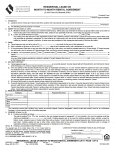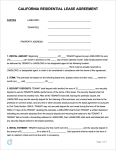California Standard Residential Lease Agreement
The California Standard Residential Lease Agreement is a formal, written arrangement between a landlord and a tenant that is typically in effect for one (1) year. It is crafted to both protect the landlord’s legal rights and property and ensure the tenant has a complete understanding of their responsibilities and the conditions of the lease. Examples of such conditions include subleasing, rent amount, utilities, and damages, to name a few.
Tenant Screening: California Rental Application
Versions (4)
Download: Adobe PDF, MS Word (.docx), Rich Text (.rtf)
 Version 2 – REALTORS (Form LR)
Version 2 – REALTORS (Form LR)
Download: Adobe PDF
 Version 3 – Realty Publications, Inc
Version 3 – Realty Publications, Inc
Download: Adobe PDF, MS Word (.docx)
Download: Adobe PDF
CA Rental Laws
Laws: §§ 1940 to 1954.05 “Hiring of Real Property”
Maximum Security Deposit: (§ 1950.5) If the apartment, house, or dwelling is furnished, the amount a landlord can request cannot be greater than three (3) months rent. If the premises is unfurnished, the amount requested as a security deposit cannot exceed two (2) months’ rent.
Returning Security Deposits: At his or her discretion, the landlord can return a security deposit within sixty (60) days prior to the expiration of a lease. However, the landlord must refund the tenant’s security deposit (minus any allowable or applicable deductions) within twenty-one (21) days after the tenant leaves the premises for good. Along with the refunded amount, the landlord must provide a written statement noting the original amount of the security deposit and the reasons for any deductions. As long as the tenant and landlord agree, the refund can be deposited into the tenant’s bank account, and the written notice detailed above can be sent by email.
Initial Inspection: In most cases, the tenant has a right to request and attend a preliminary inspection of the dwelling. The landlord should inform the tenant of this right before a lease expires; or within a “reasonable time” after the receipt or issuance of proper notification about ending the tenancy. This inspection allows the tenant to address any defects attributed to them rather than having the cost for repairs deducted from the security deposit. The tenant can elect to skip the initial inspection if he or she wishes.


